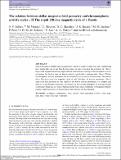The relation between stellar magnetic field geometry and chromospheric activity cycles - II The rapid 120-day magnetic cycle of τ Bootis
Abstract
One of the aims of the BCool programme is to search for cycles in other stars and to understand how similar they are to the Sun. In this paper, we aim to monitor the evolution of τ Boo's large-scalemagnetic field using high-cadence observations covering its chromospheric activity maximum. For the first time, we detect a polarity switch that is in phase with τ Boo's 120-day chromospheric activity maximum and its inferred X-ray activity cycle maximum. This means that τ Boo has a very fast magnetic cycle of only 240 days. At activity maximum τ Boo's large-scale field geometry is very similar to the Sun at activity maximum: it is complex and there is a weak dipolar component. In contrast, we also see the emergence of a strong toroidal component which has not been observed on the Sun, and a potentially overlapping butterfly pattern where the next cycle begins before the previous one has finished.
Citation
Jeffers , S V , Mengel , M , Moutou , C , Marsden , S C , Barnes , J R , Jardine , M M , Petit , P , Schmitt , J H M M , See , V , Vidotto , A A & BCool Collaboration 2018 , ' The relation between stellar magnetic field geometry and chromospheric activity cycles - II The rapid 120-day magnetic cycle of τ Bootis ' , Monthly Notices of the Royal Astronomical Society , vol. 479 , no. 4 , pp. 5266-5271 . https://doi.org/10.1093/mnras/sty1717
Publication
Monthly Notices of the Royal Astronomical Society
Status
Peer reviewed
ISSN
0035-8711Type
Journal article
Description
SJ acknowledges support from the German Science Foundation (DFG) Research Unit FOR2544 ‘Blue Planets around Red Stars’, project JE 701/3-1. VS acknowledges funding fromt the European Research Council (ERC) under the European Unions Horizon 2020 research and innovtion programme (grant agreement No 682393 AWESoMeStars).Collections
Items in the St Andrews Research Repository are protected by copyright, with all rights reserved, unless otherwise indicated.

